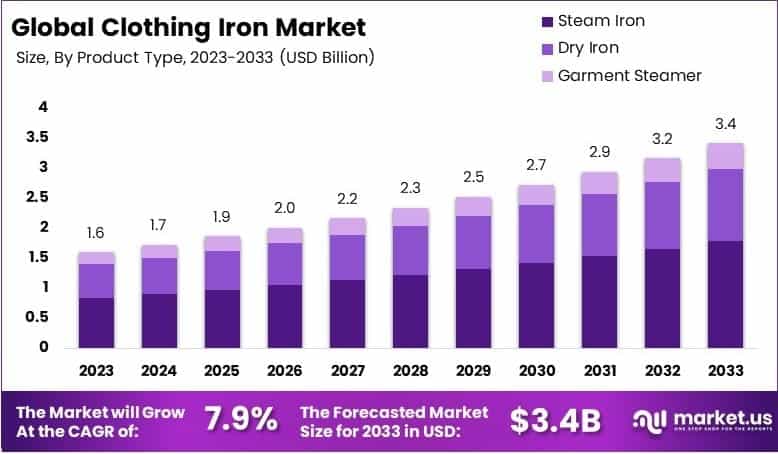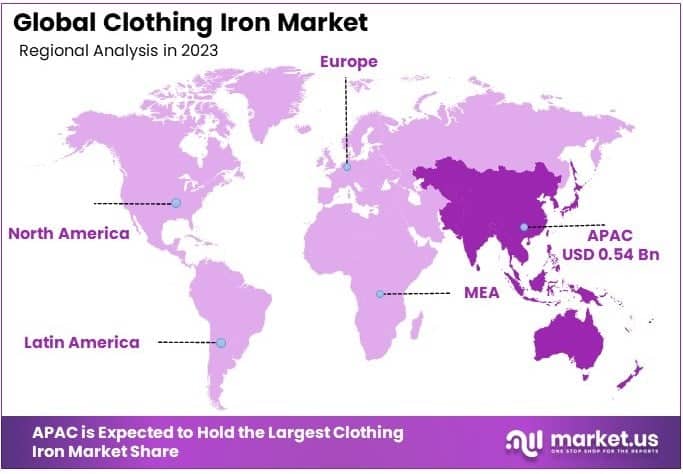Table of Contents
Introduction
The Global Clothing Iron Market is anticipated to expand from USD 1.6 billion in 2023 to around USD 3.4 billion by 2033, reflecting a compound annual growth rate (CAGR) of 7.9% throughout the forecast period from 2024 to 2033.
The clothing iron, a household appliance essential for removing wrinkles from fabrics, has evolved significantly over the years. This appliance’s primary function is to heat up and press clothes, making them presentable and crisp. The market for clothing irons encompasses the sale and distribution of various types of irons, including traditional dry irons and more advanced steam irons, which utilize steam for a more efficient and effective ironing process.
Growth factors in the clothing iron market are driven by innovations in technology, such as the integration of smart features that enhance usability and energy efficiency, appealing to environmentally conscious consumers. Additionally, the rising demand for clothing irons is fueled by increasing global urbanization and the growing middle-class population, which prioritizes professional attire and personal appearance. Opportunities within this market are abundant, particularly in developing regions where market penetration of household appliances is still expanding.
Companies are also exploring sustainable manufacturing processes and eco-friendly materials to appeal to the modern consumer, further expanding the market’s potential. The clothing iron market continues to adapt, offering products that meet the diverse needs and preferences of consumers worldwide, indicating a robust outlook for growth and innovation.

Key Takeaways
- The Clothing Iron Market is expected to grow from USD 1.6 billion in 2023 to USD 3.4 billion by 2033, marking a compound annual growth rate (CAGR) of 7.9%.
- Steam Irons, which currently hold a 52.3% share of the product type segment, are preferred for their superior ironing capabilities.
- Automatic irons, representing 55.4% of the function segment, are favored for their convenience and energy-saving features.
- The commercial sector is the largest market segment, comprising 55.1% of the market, primarily fueled by robust demand from hotels and laundry services.
- The Asia-Pacific region accounts for 33.7% of the global market, a figure that can be attributed to increasing urbanization and rising disposable incomes.
Report Scope
| Report Features | Description |
|---|---|
| Market Value (2023) | USD 1.6 Billion |
| Forecast Revenue (2033) | USD 3.4 Billion |
| CAGR (2024-2033) | 7.9% |
| Segments Covered | By Product Type (Dry Iron, Steam Iron, Garment Steamer), By Function (Automatic, Non-Automatic), By End User (Residential, Commercial), By Distribution Channel (Online, Offline: Supermarkets/Hypermarkets, Specialty Stores) |
| Competitive Landscape | GE, Bosch, Kenmore, Hamilton Beach, Black and Decker, Joy Mangano, PurSteam, Panasonic, Havells India Ltd., Koninklijke Philips N.V. |
Emerging Trends
- Eco-Friendly Designs: There is an increasing focus on developing energy-efficient and eco-friendly clothing irons to meet consumer demand for sustainable appliances.
- Advanced Steam Technology: Innovations include advanced steam generation capabilities that allow for quicker and more efficient ironing experiences.
- Smart Technology Integration: The integration of smart technology, such as automatic shut-off and temperature control, enhances user convenience and safety.
- Cordless Irons: The demand for cordless models is rising, providing users with greater mobility and convenience.
- Vertical Steamers: There is a growing popularity for vertical steamers that offer an alternative to traditional ironing, ideal for delicate fabrics and quick touch-ups.
Top Use Cases
- Home Use: Clothing irons are extensively used in residential settings for daily ironing needs.
- Hotel Industry: Hotels require efficient clothing irons to maintain crisp linens and uniforms.
- Laundry Services: Professional laundry services utilize high-power clothing irons to provide quick and effective services.
- Clothing Stores: Retail outlets use clothing irons to keep merchandise wrinkle-free and presentable.
- Workplace Settings: In professional environments, maintaining a well-groomed appearance with neatly ironed clothes is often essential.
Major Challenges
- Competition with Professional Services: Increased availability of affordable professional ironing and laundry services challenges the demand for home ironing products.
- Market Saturation: High levels of market saturation in developed regions make it challenging for new entrants and innovations to stand out.
- Economic Fluctuations: Economic downturns can lead to reduced consumer spending on non-essential goods, including advanced clothing irons.
- Technical Issues: Reliability and durability issues with some models can erode consumer trust and satisfaction.
- Energy Consumption Concerns: Consumer concern over electricity consumption can influence purchasing decisions, especially in markets sensitive to utility costs.
Top Opportunities
- Emerging Markets: Increasing disposable income in developing regions presents significant opportunities for market expansion.
- Innovative Product Offerings: Introducing innovative features such as wireless operation and improved steam functions can attract a broader customer base.
- Enhanced Distribution Channels: Expanding online sales platforms can reach a wider audience, benefiting from the growing trend of e-commerce.
- Marketing Tailored to Millennials and Gen Z: These demographic groups value efficiency and sustainability, which can be highlighted in product marketing.
- Collaboration with Fashion Industries: Partnering with clothing manufacturers and fashion retailers can enhance brand visibility and usage of advanced ironing products.
Key Player Analysis
The Global Clothing Iron Market for 2024, several key players are poised to assert significant influence. GE, with its robust technological infrastructure, is expected to enhance product efficiency and integrate smart features to cater to the tech-savvy consumer base.
Bosch, known for its commitment to sustainability and innovation, is likely to introduce energy-efficient models that align with global environmental standards. Kenmore, consistently recognized for reliability, may focus on expanding its market reach through strategic partnerships and enhanced distribution networks.
Hamilton Beach and Black and Decker are anticipated to leverage their strong brand reputations to introduce user-friendly and versatile iron models, potentially incorporating advanced steam technologies. Joy Mangano, often innovating with user-centric designs, might unveil novel features that simplify the ironing process and improve user experience.
PurSteam is expected to capitalize on its specialization in steam technology by enhancing product longevity and performance. Panasonic’s global presence and R&D capabilities should allow it to offer technologically advanced irons that cater to diverse market needs.
Havells India Ltd, with its strong foothold in the Asian market, is likely to focus on cost-effective solutions that do not compromise on quality. Lastly, Koninklijke Philips N.V is positioned to emphasize digital integration and ergonomic design, reinforcing its brand among tech-forward consumers. These developments collectively signal a competitive and dynamic market trajectory for 2024.
Top Key Players
- GE
- Bosch
- Kenmore
- Hamilton Beach
- Black and Decker
- Joy Mangano
- PurSteam
- Panasonic
- Havells India Ltd.
- Koninklijke Philips N.V
Regional Analysis
Asia-Pacific Leads Clothing Iron Market with Largest Market Share of 33.7%
In the analysis of the clothing iron market, the Asia-Pacific region emerges as the dominant segment, accounting for 33.7% of the global market share in 2024. This region’s market valuation stands at USD 0.54 billion, underscoring its substantial influence and pivotal role within the industry. The robust market performance in Asia-Pacific can be attributed to several key factors, including rapid urbanization, increasing disposable incomes, and the growing emphasis on personal appearance among the population.
Furthermore, the region benefits from the presence of several key market players who are heavily invested in product innovation and distribution network expansion. These elements collectively drive the market forward, positioning Asia-Pacific not only as a leader in market share but also as a critical hub for future market developments and trends in the clothing iron sector.

Recent Developments
- In 2023, Spectrum Brands Holdings, Inc. reached a significant agreement with the U.S. Department of Justice to address regulatory concerns over ASSA ABLOY’s acquisition of its Hardware and Home Improvement segment. This settlement marks a crucial step for Spectrum Brands in reshaping its business structure and strategy.
- In 2023, GM Modular, known for its innovation in electrical solutions and modular switches, announced its strategic entry into the home appliances market. The company plans to launch a line of clothing irons, blending functionality with modern design to cater to the evolving preferences of consumers.
- In November 2023, PVH Corp. revealed a new development in its business operations, announcing the sale of its Warners, Olga, and True & Co. brands to Basic Resources for $160 million. This deal includes an additional earnout potential, depending on 2024 sales, emphasizing PVH’s strategic realignment within the apparel industry.
- In 2023, Charli XCX became the face of Acne Studios’ Spring 2025 campaign. The campaign, captured by Talia Chetrit, showcases the synergy between the artist’s dynamic style and the brand’s innovative designs. Charli XCX’s involvement highlights her personal connection to the brand, enhancing its appeal to a broader audience.
Conclusion
The global clothing iron market is poised for significant growth, driven by technological advancements and increasing consumer demand for efficient, eco-friendly appliances. Innovations such as smart technology integration and energy-efficient designs are reshaping the market landscape, catering to the modern consumer’s preference for convenience and sustainability. Additionally, the rising middle-class population and rapid urbanization in regions like Asia-Pacific further fuel market expansion. The market’s dynamic nature is characterized by the continuous evolution of product offerings and strategic initiatives by key players to enhance consumer engagement and market penetration. These factors collectively contribute to a promising future for the clothing iron industry, emphasizing its crucial role in meeting both current and future consumer needs.
Discuss Your Needs With Our Analyst
Please share your requirements with more details so our analyst can check if they can solve your problem(s)





